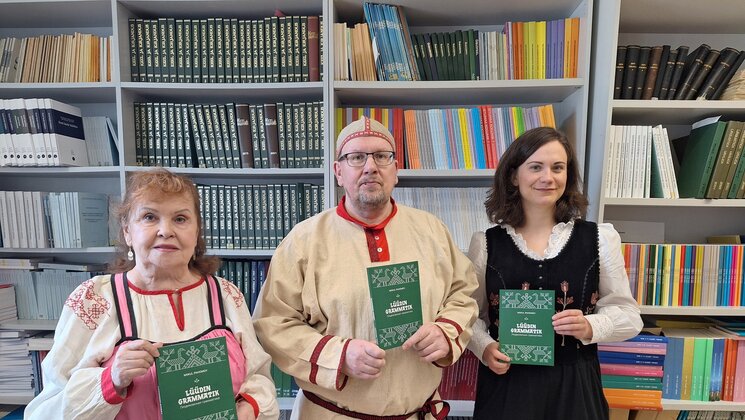Anja Arnhold (Alberta): "Finnish prosody: Typology, focus marking and the architecture of grammar"
1. novembril peab Anja Arnhold Alberta Ülikoolist TÜlingu loengusarja raames ettekande pealkirjaga "Finnish prosody: Typology, focus marking and the architecture of grammar". Kõik on oodatud ettekannet kuulama kell 16.00-17.15 aadressil Jakobi 2-427. Loe ettekande teese alt poolt. TÜlingu loengusarja kogu semestri kava leiad siit.
Ettekande teesid:
Prosodic focus marking in Finnish is particularly interesting from a typological perspective. First, it provides evidence that Finnish is part of an under-described class of languages that makes no categorical distinctions between pitch movements. It thereby differs both from tone languages, which use pitch differences to make lexical distinctions (e.g. Mandarin má ‘mother’ vs. mâ ‘scold’), as well as from intonation languages, which use pitch to make pragmatic distinctions (e.g. English Now? vs. Now!). Unlike the best-studied European intonation languages, Finnish does not use different types of pitch accents to highlight focused constituents and deaccenting given constituents (e.g. English Who hates flying? – The PROFESSOR hates flying. vs. Does the professor like flying? – The professor HATES flying.). Instead, as I have shown in past work, Finnish prosodic focus marking can largely by characterized in terms of adjustments to phrasing and phrase marking (Arnhold, 2014a, 2016, 2019; Arnhold & Kyröläinen, 2017). Accordingly, Finnish and languages like it (e.g. Kalaallisut, see Arnhold, 2014b; Hindi, see Féry et al., 2016; Turkish, see Güneş, 2014), are classified as phrase languages in the sentence-level prosodic typology of Féry (Féry, 2010, 2017).
Second, like in other Finno-Ugric languages, variation in word order expresses focus and other aspects of information structure in Finnish (Vilkuna, 1989, 1995). This means that there is more than one grammatical tool for marking focus in Finnish, and prosodic and syntactic means can be used in interaction (Arnhold et al., 2016; Arnhold & Féry, 2013; Vainio & Järvikivi, 2007). I will report an ongoing project that investigates the implications of this fact for our conception of the architecture of grammar. In particular, it is commonly assumed that grammar is optimally evolved for communication and thereby efficient, avoiding redundancy (see overview in Reinhart, 2006). Moreover, the overall complexity of grammar is restricted by general cognitive limits (Kortmann & Szmrecsanyi, 2012; Sampson et al., 2009; Yadav et al., 2020). From this follows the prediction of prosody-syntax trade-offs, which this project tests experimentally (also see Arnhold, 2021).
Finally, time permitting, I will present a collaborative research on a case of prosody-only focus marking, namely focus on different constituents within noun phrases in Finnish (also see Arnhold, 2015), Hungarian (with Corinna Langer and Frank Kügler, Goethe-University Frankfurt) and Estonian (with Nele Ots, Goethe-University Frankfurt and University of Tartu).
References:
Arnhold, A. (2014a). Finnish prosody: Studies in intonation and phrasing [PhD thesis]. Goethe-University Frankfurt am Main.
Arnhold, A. (2014b). Prosodic structure and focus realization in West Greenlandic. In S.-A. Jun (Ed.), Prosodic typology II. The phonology of intonation and phrasing (pp. 216–251). Oxford University Press. https://doi.org/10.1093/acprof:oso/9780199567300.003.0008
Arnhold, A. (2015). What do compounds and noun phrases tell us about tonal targets in Finnish? Nordic Journal of Linguistics, 38(02), 221–244. https://doi.org/10.1017/S033258651500013X
Arnhold, A. (2016). Complex prosodic focus marking in Finnish: Expanding the data landscape. Journal of Phonetics, 56, 85–109. https://doi.org/10.1016/j.wocn.2016.02.002
Arnhold, A. (2019). Finnish, focus and Féry’s prosodic typology. In G. Kentner, F. Kügler, B. Moskal, & S. Skopeteas (Eds.), Tweets’n greets for Caroline Féry on the occasion of her farewell from Goethe-University Frankfurt (pp. 1–5). Department of Linguistics, Goethe-University Frankfurt am Main.
Arnhold, A. (2021). Prosodic focus marking in clefts and syntactically unmarked equivalents: Prosody – syntax trade-off or additive effects? Journal of the Acoustical Society of America, 149(3), 1390–1399. https://doi.org/10.1121/10.0003594
Arnhold, A. (2014a). Finnish prosody: Studies in intonation and phrasing [PhD thesis]. Goethe-University Frankfurt am Main.
Arnhold, A. (2014b). Prosodic structure and focus realization in West Greenlandic. In S.-A. Jun (Ed.), Prosodic typology II. The phonology of intonation and phrasing (pp. 216–251). Oxford University Press. https://doi.org/10.1093/acprof:oso/9780199567300.003.0008
Arnhold, A. (2015). What do compounds and noun phrases tell us about tonal targets in Finnish? Nordic Journal of Linguistics, 38(02), 221–244. https://doi.org/10.1017/S033258651500013X
Arnhold, A. (2016). Complex prosodic focus marking in Finnish: Expanding the data landscape. Journal of Phonetics, 56, 85–109. https://doi.org/10.1016/j.wocn.2016.02.002
Arnhold, A. (2019). Finnish, focus and Féry’s prosodic typology. In G. Kentner, F. Kügler, B. Moskal, & S. Skopeteas (Eds.), Tweets’n greets for Caroline Féry on the occasion of her farewell from Goethe-University Frankfurt (pp. 1–5). Department of Linguistics, Goethe-University Frankfurt am Main.
Arnhold, A. (2021). Prosodic focus marking in clefts and syntactically unmarked equivalents: Prosody – syntax trade-off or additive effects? Journal of the Acoustical Society of America, 149(3), 1390–1399. https://doi.org/10.1121/10.0003594
Arnhold, A., Chen, A., & Järvikivi, J. (2016). Acquiring complex focus marking: Finnish four- to five-year-olds use prosody and word order in interaction. Frontiers in Psychology, 7, 1886. https://doi.org/10.3389/fpsyg.2016.01886
Arnhold, A., & Féry, C. (2013). The role of syntactic flexibility and prosody in marking given/new distinctions in Finnish. Finno-Ugric Languages and Linguistics, 2(2), 2–32.
Arnhold, A., & Kyröläinen, A.-J. (2017). Modelling the interplay of multiple cues in prosodic focus marking. Laboratory Phonology: Journal of the Association for Laboratory Phonology, 8(1), 4. https://doi.org/10.5334/labphon.78
Féry, C. (2010). Indian languages as intonational “phrase languages.” In I. Hasnain & S. Chaudhury (Eds.), Problematizing language studies. Festschrift for Rama Agnihotri (pp. 288–312). Aakar Books.
Féry, C. (2017). Intonation and prosodic structure. Cambridge University Press. https://doi.org/10.1017/9781139022064
Féry, C., Pandey, P., & Kentner, G. (2016). The prosody of focus and givenness in Hindi and Indian English. Studies in Language, 40(2), 302–339. https://doi.org/10.1075/sl.40.2.02fer
Güneş, G. (2014). Constraints on syntax-prosody correspondence: The case of clausal and subclausal parentheticals in Turkish. Lingua, 150, 278–314. https://doi.org/10.1016/j.lingua.2014.07.021
Kortmann, B., & Szmrecsanyi, B. (Eds.). (2012). Linguistic complexity. Second language acquisition, indigenization, contact. De Gruyter.
Reinhart, T. (2006). Focus: The PF interface. In T. Reinhart (Ed.), Interface strategies: Optimal and costly computations (pp. 125–163). MIT Press.
Sampson, G., Gil, D., & Trudgill, P. (Eds.). (2009). Language complexity as an evolving variable. Oxford University Press.
Vainio, M., & Järvikivi, J. (2007). Focus in production: Tonal shape, intensity and word order. The Journal of the Acoustical Society of America, 121(2), EL55–EL61. https://doi.org/10.1121/1.2424264
Vilkuna, M. (1989). Free word order in Finnish: Its syntax and discourse functions. Suomalaisen Kirjallisuuden Seuran Toimituksia.
Vilkuna, M. (1995). Discourse configurationality in Finnish. In K. É. Kiss (Ed.), Discourse configurational languages (pp. 244–268). Oxford University Press.
Yadav, H., Vaidya, A., Shukla, V., & Husain, S. (2020). Word order typology interacts with linguistic complexity: A cross-linguistic corpus study. Cognitive Science, 44(4). https://doi.org/10.1111/cogs.12822


